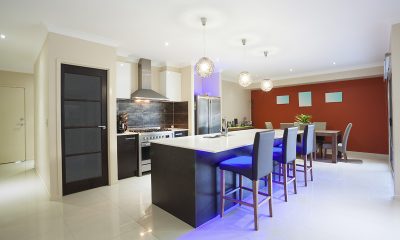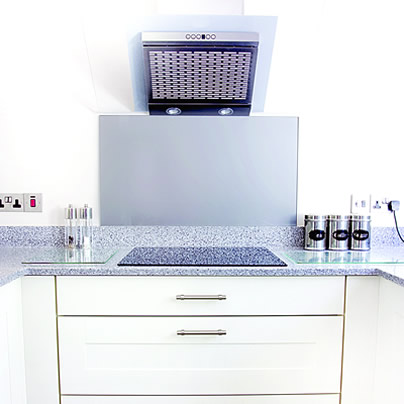Real Estate
Counter intelligence
After black granite, what’s next for kitchen surfaces?
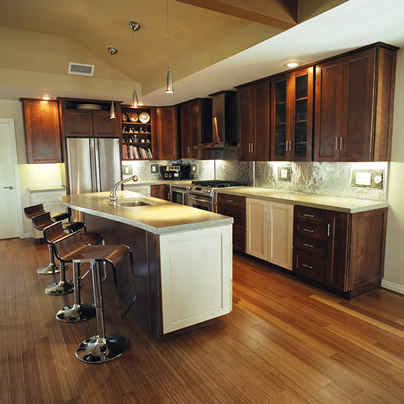

(Photo courtesy of Blake)
Is anyone out there as sick of black granite as I am?
We first saw this trend nearly 10 years ago as a striking contrast – natural maple cabinets with Absolute Black or Black Galaxy countertops. Our kitchens were touted as “gourmet” just because they featured stainless steel appliances, maple or cherry cabinets and granite counters. Now that this is the standard found in even entry-level condos, homeowners searching for the next trend in upscale surfaces are weighing their options.
Quartz is a very popular one, with brand names like Silestone, Cambria and Caesarstone leading the pack. In addition to the solids, pearl and stone-like surfaces we know, they are now available in matte finishes which can look spectacular against today’s glass tile backsplashes. Easy to care for with no sealing required, they range in price from $60 to $150 per square foot, installed.
Marble counters and backsplashes are marking the return of white to today’s kitchens. Paired with bright white or espresso finish cabinets, they present a clean, polished look when installed with stainless steel appliances. Since you’ll be paying top dollar at $125 to $250 per square foot, be prepared to invest some time in maintaining that look as marble tends to stain easily.
Recycled glass is still a relatively new addition to the list of environmentally friendly countertops. You can find products like Enviroglass and Ice Stone that have recycled bits of glass embedded in a resin that forms the countertop. With Vetrazzo, you can select your own mix of color additives. Thinkglass, Inc., a Canadian company, will help you create a work of art with bubbles and multi-colored swirls for both residential and commercial installation. Expect to pay $75 to $125 per square foot.
Concrete offers the opportunity to be very creative, not only with colors, but also with additives like marbles, shells, bits of glass and even fiber optics. You can also create any shape you wish during the formulation process. Although concrete is treated with a paste wax sealant, don’t set your bottle of red wine directly on the counter and do wipe up any spills immediately. $75 to $200 per square foot will get you a custom concrete countertop.
Haven’t hit upon your heart’s desire yet? Here are some other alternatives.
Butcher block is making a comeback, especially as an accent on a country kitchen island.
Bamboo is the new butcher block. You can install a flat, vertical, or parquet end grain.
Remember Dupont Corian? Check out the new Corian loves Missoni designs with an Italian twist.
Soapstone is generally available in shades of blue, gray and black. It has a classic look and does not stain easily.
Stainless steel is also popular. Try using it atop more traditional cabinets for an eclectic look that doesn’t feel cold or sterile.
Paperstone is made of – you guessed it – paper. It’s available in nine colors with designs that can even mimic leather.
Recycled aluminum counters from a company called Alkemi are reminiscent of the “threads” found in vintage Formica from the 1950s. The slabs come in several colors and in both classic (shiny) and honed finishes.
Gem Surfaces, located in Arizona, produces a variety of exquisite, high-end look with gemstones like agate, jasper, amethyst, jade, mother of pearl and more. But be forewarned: a little bit goes a long way.
Pyrolave, a French company, produces a glazed, volcanic lava stone that looks like glass but is far more durable.
And for the truly creative among us: Design your own. With clear resin and a form built to the size and shape of your new countertop, add texture with sea grass, dried flowers, coins, or small objets d’art. Whatever you choose, make it a one-of-a-kind piece that reflects your personality. For a price ranging from $50.00 to $125.00 per square foot you may well start the next trend in kitchen design. After ten years of black granite, we certainly need one.
Valerie M. Blake is with Prudential PenFed Realty, an independently owned and operated broker member of BRER Affiliates, Inc. Reach her at 202-246-8602 or [email protected]. Prudential, the Prudential logo and the Rock symbol are registered service marks of Prudential Financial, Inc. and its related entities, registered in many jurisdictions worldwide. Used under license with no other affiliation with Prudential. Equal Housing Opportunity.
Real Estate
How federal layoffs, shutdown threaten D.C.-area landlords
When paychecks disappear, the shock doesn’t stop at the Beltway

When federal paychecks disappear, the shock doesn’t stop at the Beltway. It lands on the doorsteps of the region’s property owners, those who rent out their rowhouses in Petworth, condos in Crystal City, and homes stretching into Montgomery and Prince George’s counties. Landlords depend on steady rent from tenants employed by the very institutions that are now downsized or worse, shuttered.
This fall, Washington’s economic identity is being tested once again. Thousands of federal workers who accepted “deferred resignation” packages will soon lose their income altogether. And with a long government shutdown looming, even those still on the payroll face delayed paychecks. For landlords, that combination of uncertainty and sudden income loss threatens to unsettle a rental market already balancing on the edge.
A Test of Resilience
Rosie Allen-Herring, president of United Way of the National Capital Area, recently told The Washington Post, “This region stands to take a hard hit from those who are no longer employed but can’t find new employment and now find themselves in need. It’s a full-circle moment to be a donor and now find yourself in need, but it is very real for this area.” 1 That reversal captures the broader moment: The D.C. economy built on federal paychecks and charitable giving now faces a stress test of compassion and cash flow alike.
For landlords, adaptability will determine who weathers the storm. Those who are able to keep the rent coming in, retain their tenants or find replacement tenants without the same economic hardships are going to be able to get to the other side with manageable financial disruptions. Those who plan, communicate, and stay financially flexible will keep their properties occupied and their reputations intact.
A Region Built on Federal Pay
Roughly one in ten jobs in the Washington metropolitan area is tied directly to the federal government, according to the Bureau of Labor Statistics. That number climbs sharply when you include contractors, nonprofits, and think tanks dependent on federal funding.
This concentration means that when the federal government sneezes, D.C.’s housing market catches a cold. The Brookings Institution recently reported that since January, the region’s unemployment rate has climbed eight times faster than the national average, and local job growth has flattened. 1 More anecdotal, I’ve spoken with property owners this year who are looking to rent out the property they own in DC because they have to move to another region for work.
As The Post observed, “The region has shed federal jobs at a higher rate, and both the number of homes for sale and the share of residents with low credit scores have grown more quickly here than the rest of the country.” 1
For landlords, that’s a flashing warning light. When a certain category of tenants with solid compensation lose reliable government salaries and face dim re-employment prospects, rent becomes harder to collect and rent levels can decline year on year.
The Human Side of a Policy Shock
The people behind these statistics are often long-tenured civil servants. The Post profiled former State Department employee Brian Naranjo, who said he had “unsuccessfully thrown his résumé at more than 50 positions since resigning in May.” “It’s terrible,” Naranjo told the paper. “You have far more people going for those very specialized jobs than would normally be out there.” 1
Another displaced worker, Jennifer Malenab, a 42-year-old former Department of Homeland Security employee, described canceling daycare and family vacations while she scours job boards. “This is not where you want to be at 42, with a family,” she said. 1
When households like these lose steady pay, not only do they pull back on spending, but if they are renters landlords may see a lag in rent receipts, requests for partial payments, or in some cases, a premature notice to vacate. Some tenants will relocate out of the region altogether — a prospect already visible in rising “for sale” listings and increased moving-truck activity in Northern Virginia and suburban Maryland.
What Happens When the Rent Doesn’t Arrive
When rent payments are disrupted, even temporarily, the financial effects can be immediate. Many small landlords depend on rent to cover their mortgages, property taxes, insurance premiums, and routine maintenance. Even a temporary interruption in income can deplete reserves, delay repairs, and strain their ability to meet loan obligations.
Larger multifamily owners are not immune. If multiple tenants in a building lose income at once, cash flow can fall sharply. During the brief 2019 government shutdown, some D.C. landlords offered short-term payment plans to furloughed workers with the expectation of eventual back pay. However, under current conditions, where many positions are being permanently eliminated and paychecks may not be restored, landlords face much greater uncertainty and cannot assume repayment will be guaranteed.
In the District of Columbia, the Rental Housing Commission has advised landlords to continue operating strictly within established legal procedures and to avoid informal or selective payment arrangements that could be interpreted as discriminatory under the D.C. Human Rights Act. Courts in Virginia and Maryland allow temporary continuances when tenants provide documentation of a federal furlough or income disruption, but it is the court, not the landlord, that determines eligibility for relief.
How Landlords Should Proceed
- Continue filing nonpayment cases through normal legal channels rather than delaying action.
- Allow the courts to apply any continuance or relief provisions if a tenant qualifies due to federal employment status or income interruption.
- Avoid making selective accommodations based on a tenant’s job type or federal employment status, as this may violate equal-treatment and source-of-income protections.
Landlords with a single tenant or a consistent written policy of offering payment plans to all tenants experiencing verified income disruption should not be at risk of discriminatory treatment.
Vacancy, Concessions, and Shifting Demand
Beyond nonpayment of rent, landlords face a challenge from a different direction: weak demand. As fewer jobs are being created and unemployed or under-employed tenants move out of DC, the supply of available rental units will rise, forcing landlords to compete more aggressively on price and amenities.
Market data already point that direction. The volume of rental listings across the District of Columbia jumped roughly 14 percent year-over-year in September, according to the realtor Multiple Listing Service (MLS) trends, as reported by the Washington Business Journal. Landlords are offering free parking, one-month concessions, or flexible leases to retain quality tenants.
Neighborhoods once buffered by federal stability like Silver Spring, Falls Church, and Alexandria may now see higher tenant turnover. As one Arlington property manager put it, “We used to say federal employees were the safest tenants in America. Now we’re rewriting that rule.”
A Shrinking Workforce, a Softer Market
In addition to the layoffs, the region is contending with a broader identity crisis. “Yesim Sayin, executive director of the D.C. Policy Center, put it bluntly: ‘Beyond federal employment, we relied on tourism. But foreign tourists aren’t coming. And we relied a whole lot on universities bringing talent who would then stay here and be part of our talent pool. And that is kind of gone, too. So what are we now? We just don’t know.’” 1
This uncertainty may impact property values and investor sentiment. When employers relocate, renters follow. If enough mid-career professionals leave, demand for rentals will first soften and then we’ll begin to see a lowering of the average rents a landlord can command for their rental. We have already seen this in the current rental market. Rents that seems reasonable a few years ago, are now being discounted by hundreds of dollars. Landlords who are searching for new renters after several years of having tenants are finding that they need to bring rent levels below where they used to be to secure tenants commitments.
Strategies for Landlords: Staying Solvent and Supportive
In times like these, survival depends on both prudence and empathy.
1. Communicate early. Encourage tenants to disclose financial hardship before missing payments. Written payment plans, properly documented, can forestall eviction while preserving goodwill.
2. Review legal protections. Understand D.C., Maryland, and Virginia rules regarding furlough continuances or income-source discrimination. Seek legal counsel before altering lease terms mid-cycle.
3. Build reserves and credit access. Line up a home-equity or business line of credit to bridge shortfalls. Cash on hand always is helpful to have as a buffer for the impact of income disruption.
4. Monitor policy developments. State and local governments are supporting people who are affected by the lay-offs. Landlords can benefit indirectly through their renters who are utilizing these programs to assist them in paying their monthly expenses.
5. Contact your Congressional representatives to demand the reopening of the federal government. And in D.C., you do benefit from representation, even though they cannot vote. They can influence decisions that matter.
Scott Bloom is owner and senior property manager of Columbia Property Management.
Real Estate
Real terrors of homeownership come from neglect, not ghosts
Mold, termites, frayed wires scarier than any poltergeist
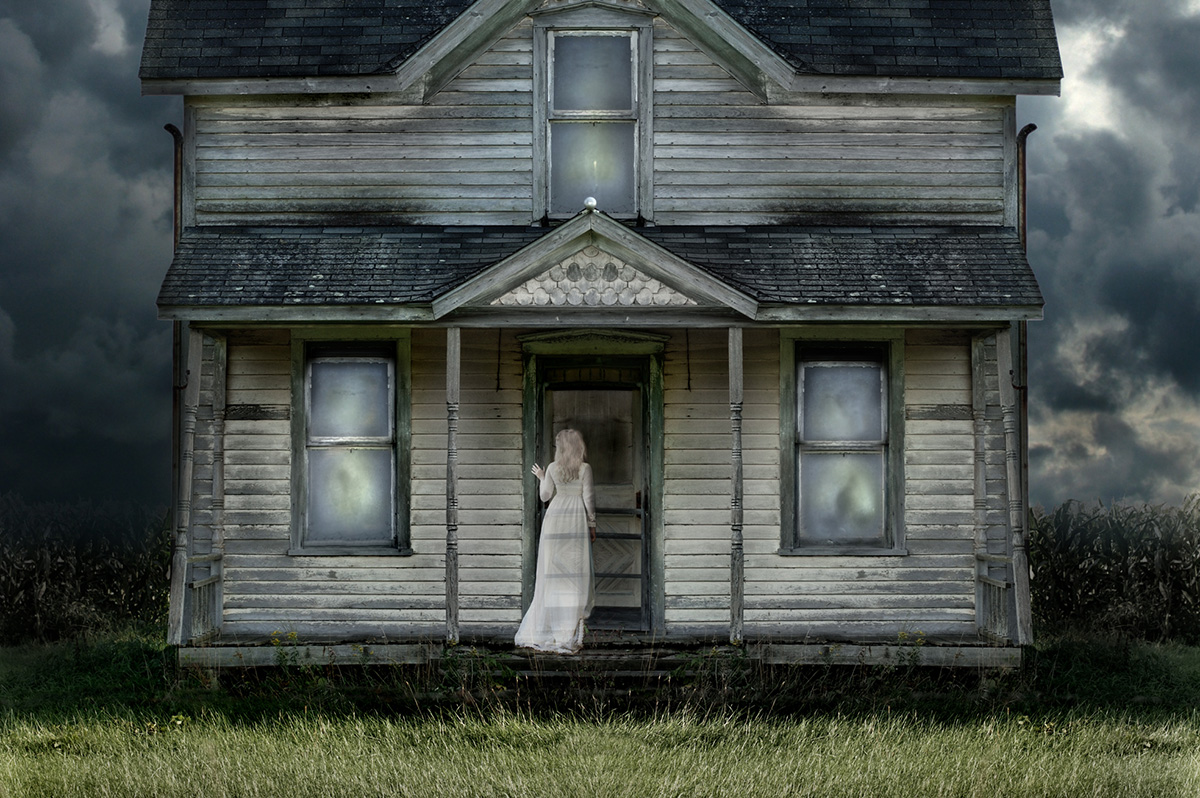
Each October, we decorate our homes with cobwebs, skeletons, and flickering jack-o’-lanterns to create that spooky Halloween atmosphere. But for anyone who’s ever been through a home inspection there’s no need for fake scares. Homes can hide terrors that send chills down your spine any time of year. From ghostly noises in the attic to toxic monsters in the basement, here are some of the eeriest (but real) things inspectors and homeowners discover.
Every haunted house movie starts with a creepy basement, and in real life, it’s often just as menacing. Mold, mildew, and hidden water leaks lurk down there like invisible phantoms. At first, it’s just a musty smell — something you might brush off as “old house syndrome,” but soon enough, you realize those black or green patches creeping along the walls can be more sinister than any poltergeist.
Black mold (Stachybotrys chartarum) is particularly fearsome – it thrives in damp, dark places and can cause serious respiratory problems. It’s not just gross – it’s toxic and, while some types of mold can be easily cleaned up, removing black mold can cost more than an exorcism.
Have you ever heard strange buzzing or seen flickering lights that seem to move on their own? Before you call the Ghostbusters, call an electrician. Faulty wiring, outdated panels, and aluminum circuits from the mid-20th century are the true villains behind many mysterious house fires. Home inspectors can also find open junction boxes, frayed wires stuffed behind walls, or overloaded breaker panels that hum like a restless spirit.
Imagine an invisible specter floating through your home – something that’s been there since the 1950s, waiting for you to disturb it. That’s asbestos. Home inspectors dread discovering asbestos insulation around old boilers or wrapped around ductwork. It’s often lurking in popcorn ceilings, floor tiles, and even wall plaster. You can’t see it, smell it, or feel it—but inhaling those microscopic fibers can lead to serious illness decades later.
Lead pipes, once thought to be durable and reliable, are like the vampires of your water system – quietly poisoning what sustains you. The results of a lead test can be chilling: even a small amount of lead exposure is dangerous, particularly for children.
And it’s not just pipes – lead paint is another problem that refuses to die. You might find it sealed beneath layers of newer paint, biding its time until it chips or flakes away. This is why, when selling a property built prior to 1978, homeowners must disclose any knowledge of lead paint in the home and provide any records they may have of its presence or abatement.
Scratching in the walls. Tiny footsteps overhead. Droppings in the attic. It’s not a poltergeist – it’s pests. Termites, rats, bats, carpenter ants, and even raccoons can do more damage than any ghost ever could.
Termites are the silent assassins of the home world, chewing through beams and joists until the structure itself starts to sag. Rats and mice leave behind droppings that can spread disease and contaminate food. Bats are federally protected, meaning your haunted attic guests can’t just be evicted without proper precautions. And I once had a raccoon give birth in my chimney flue; my dogs went crazy.
Ever step into a home and feel the floors tilt under your feet? That’s no ghostly illusion – it’s the foundation shifting beneath you. Cracked walls, doors that won’t close, and windows that rattle in their frames are the architectural equivalent of a horror movie scream.
Foundation damage can come from settling soil, poor drainage, or tree roots rising from under the structure. In extreme cases, inspectors find entire crawl spaces flooded, joists eaten by rot, or support beams cracked like brittle bones. Repair costs can be monstrous – and if left unchecked, the whole house could become a haunted ruin.
Some homes hold more than just physical scares. Behind the drywall or under the floorboards, inspectors may uncover personal relics – old letters, photographs, even hidden safes or forgotten rooms. Occasionally, however, there are stranger finds: jars of preserved “specimens,” taxidermy gone wrong, or mysterious symbols scrawled in attic spaces.
These discoveries tell stories of the people who lived there before, sometimes fascinating, sometimes chilling, but they all add to the eerie charm of an old home, reminding us that every house has a history — and some histories don’t like to stay buried.
So, while haunted houses may be a Halloween fantasy, the real terrors in homeownership come from neglect, not ghosts. Regular inspections, good maintenance, and modern updates are the garlic and holy water that turn a trick of a home into a treat.
Valerie M. Blake is a licensed associate broker in D.C., Maryland, and Virginia with RLAH @properties. Call or text her at 202-246-8602, email her via DCHomeQuest.com, or follow her on Facebook at TheRealst8ofAffairs.
Real Estate
LGBTQ home ownership index 2025
Half of queer buyers have experienced or suspected discrimination

Half of LGBTQ+ buyers in the United States say they have experienced or suspected discrimination during the housing process, a new survey commissioned by Gay Real Estate has found. That single figure captures the reality behind one of life’s biggest milestones: buying a home is still not an equal journey for everyone.
Discrimination does not just hurt feelings. It limits access to neighborhoods, delays buying decisions, and pushes many to conceal who they are in order to secure housing. These patterns reveal the added weight LGBTQ+ people carry in a process that should be about opportunity and stability.
At Gay Real Estate, our mission is to connect LGBTQ+ individuals with trusted agents who understand these challenges and provide supportive guidance throughout the buying process. To explore this, we put together The LGBTQ+ Home Ownership Index 2025, which draws on new survey data to uncover these challenges, showing how identity influences every stage of the housing journey. From neighborhood choice to financing, here’s the data that highlights both the barriers and the resilience of LGBTQ+ buyers…
Discrimination Shapes the Homebuying Journey
Discrimination does not always take place in obvious forms. It might surface during an initial phone call, a property viewing, or even while negotiating terms. For LGBTQ+ buyers, these moments are often enough to alter decisions about whether to proceed at all. In fact…
- 33% have experienced discrimination due to their LGBTQ+ identity when in the home buying process.
- 17% suspected they were discriminated against, but could not be certain it was due to their identity.
- Combined, this means half of LGBTQ+ buyers report experiencing or suspecting discrimination.
For many, this ongoing risk changes the way they approach each stage of the process. Some hesitate to enquire about certain properties, while others walk away from negotiations when bias appears. These are not isolated frustrations but a pattern that continues to influence housing access nationwide.
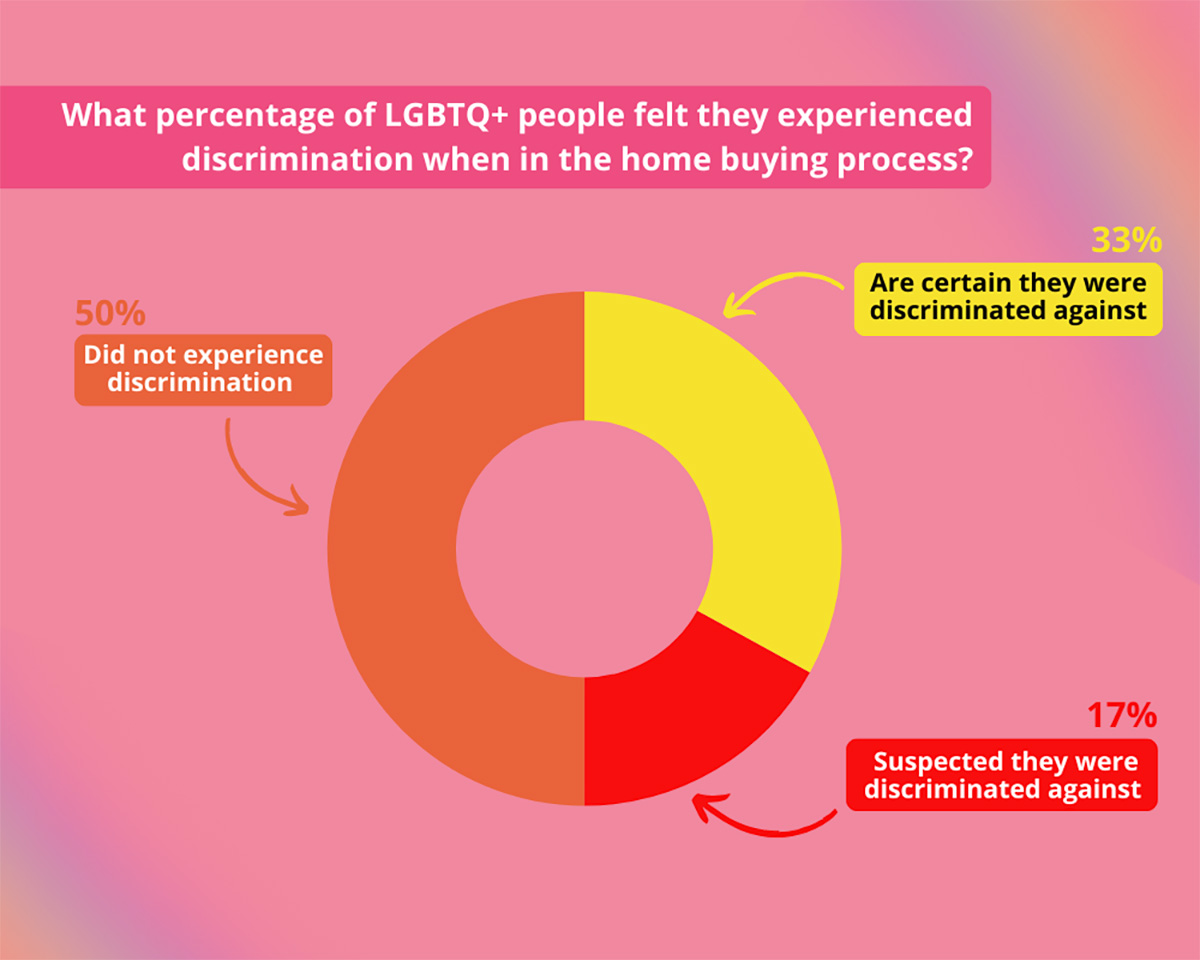
Why Many Feel Pressure to Conceal their Identity
A striking 67% of the LGBTQ+ people surveyed either have hidden, considered hiding their identity, were pressured to hide their identity, or had limited disclosure of their identity while navigating the housing market. This can occur during property viewings, mortgage applications, or even casual conversations with landlords and neighbors.
This concealment is not about preference but survival. LGTBQ+ homebuyers weigh the risk of being open against the potential of being denied, steered elsewhere, or subjected to worse terms. The reality is that many feel they must downplay who they are in order to secure something as fundamental as a home.
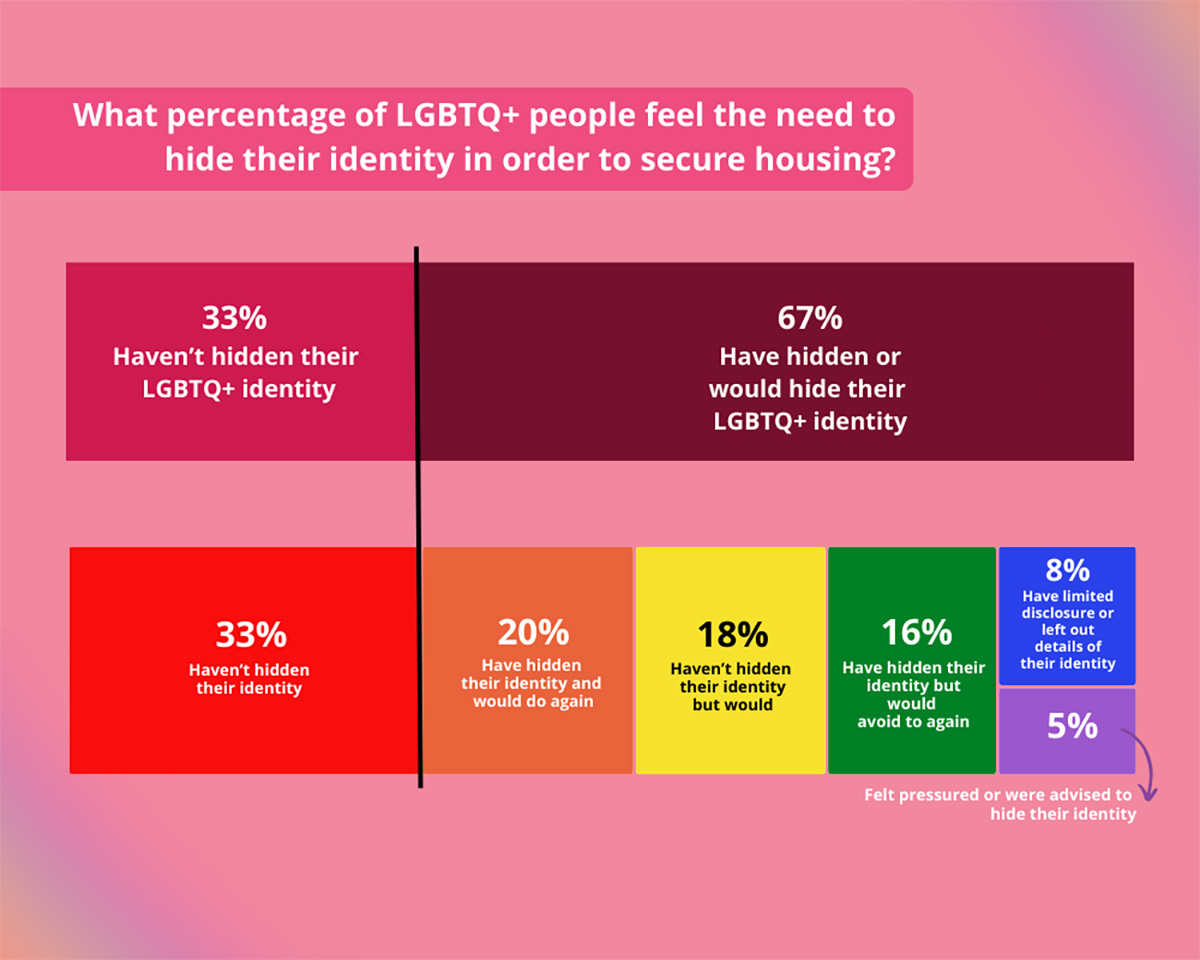
How Neighborhood Choice is Limited by Discrimination
Location is a defining factor in real estate, yet for LGBTQ+ buyers it’s not just about schools, commute times, or amenities. It’s also about whether they feel comfortable walking around the streets, holding a partner’s hand, or participating in local life. The survey results show how deeply these considerations shape decisions:
- 22% have avoided certain areas due to fear of LGBTQ+ discrimination.
- 30% would avoid areas in the future for the same reason.
- 24% have at least considered avoiding certain areas.
Feelings of unease extend beyond neighborhoods. Eight in ten report experiencing at least some level of discomfort or risk that changes their behavior. This might mean avoiding viewings at night, skipping certain open houses, or limiting their search to areas perceived as more welcoming.
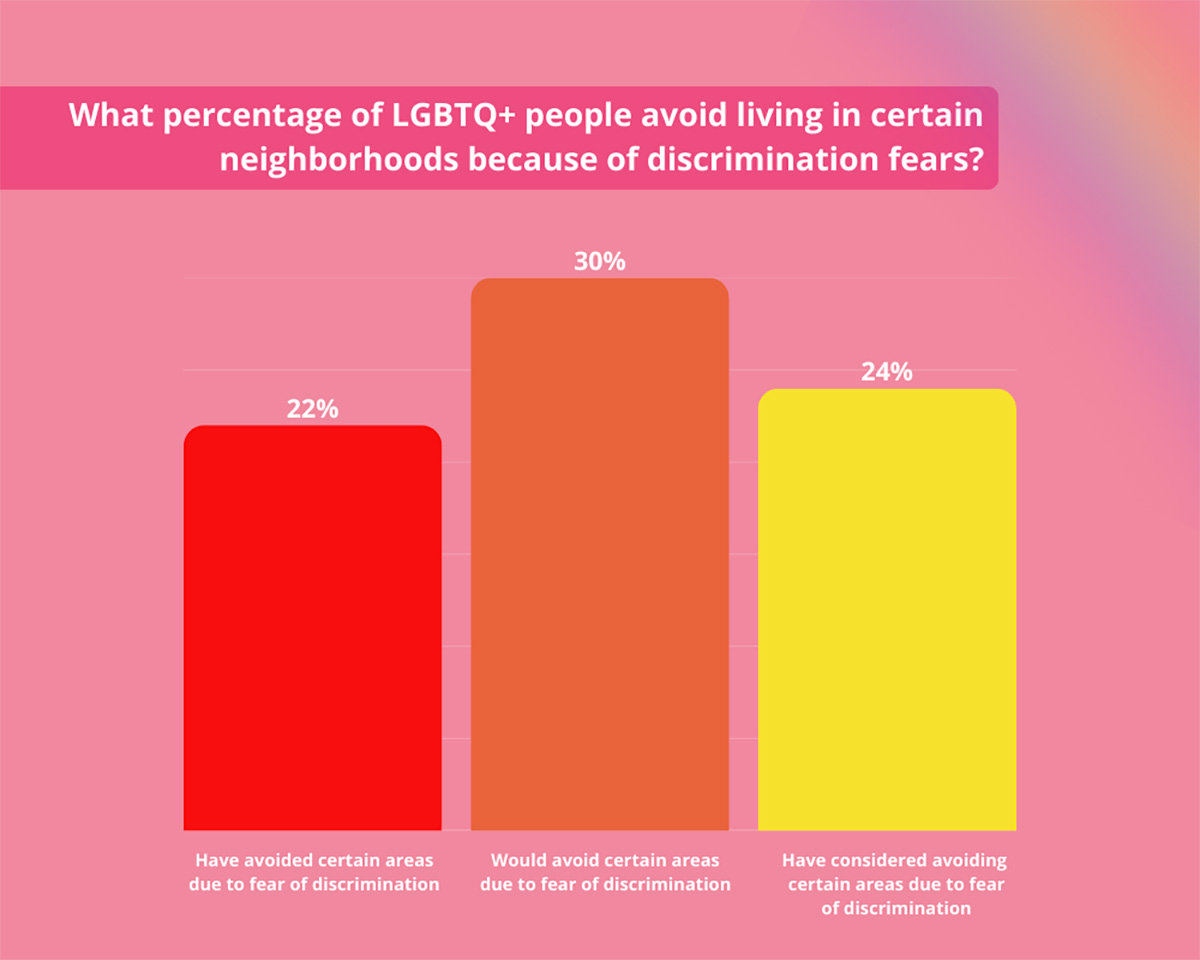
Politics, Legislation, and Timing
The decision to buy a home often comes with timing questions about jobs, interest rates, and personal finances. For LGBTQ+ buyers, the political and legal climate can be just as influential, with 24% reporting that they have delayed buying a home, and 17% are considering delaying because of these concerns. On top of this, 12% have even decided not to buy at all.
Altogether, 53% report that political or legal conditions have directly shaped when or whether they buy. These delays are not about whether or not they can make the decision, but about careful risk management. Many want assurance that their rights and investments will be protected before taking such a significant financial step.
The Cost of an LGBTQ-Friendly Area
For most people, cost is the single biggest factor in choosing where to live, yet 3 in 5 LGBTQ+ buyers are willing to pay more to live in areas they know will be affirming.
Combined, 60% are willing to trade financial savings for the stability and predictability of an affirming environment. This is not treated as a luxury but as a necessity, one that enables people to live more freely and fully in their own homes.
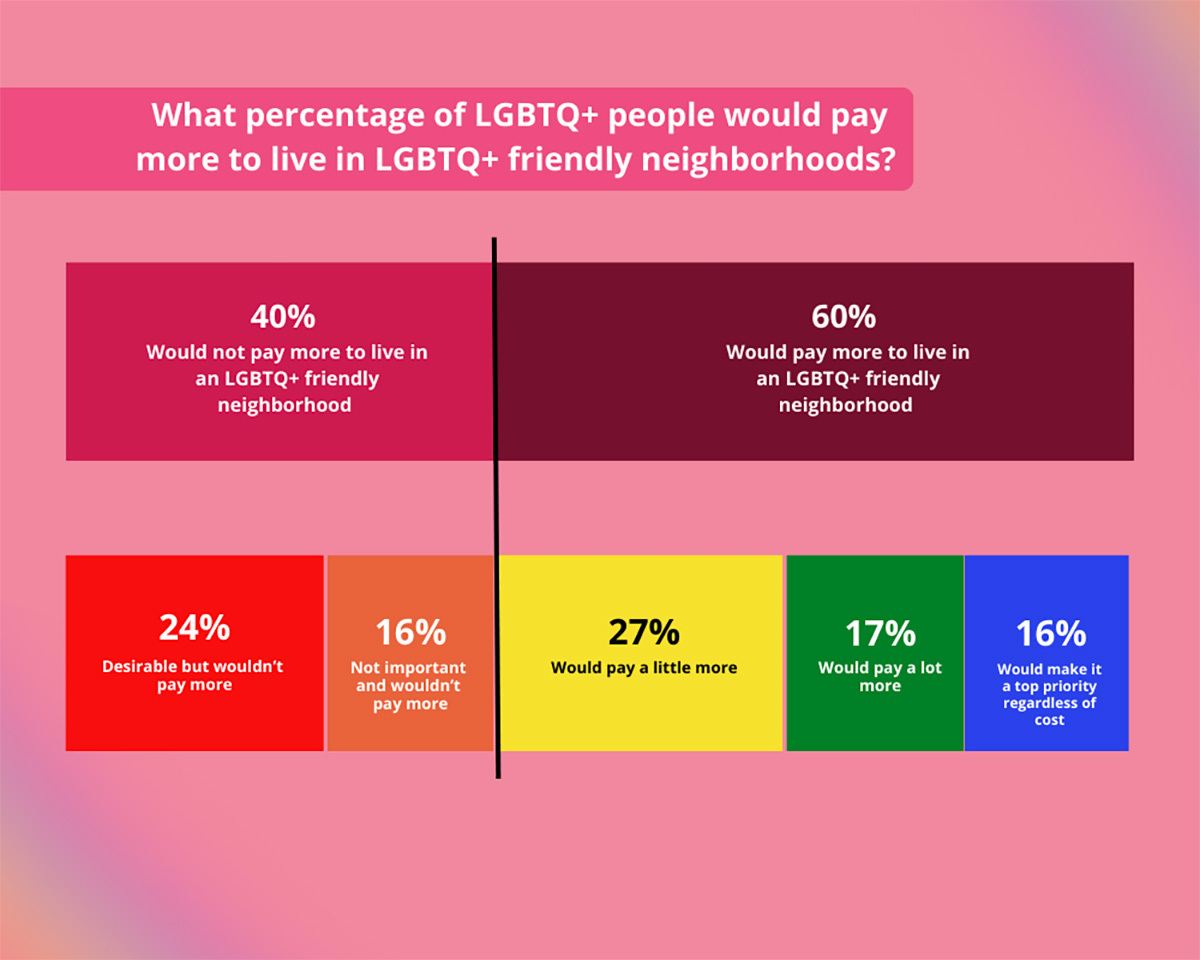
LGBTQ-Friendly States and Cities
When it comes to LGBTQ+ friendly places to buy a home, certain U.S. states and cities stand out. Our recent survey of 700 respondents revealed which areas are top of mind for prospective LGBTQ+ homeowners.
California
Leading the way, California was cited by 17.6% of respondents. Homebuyers here highlight strong legal protections, vibrant communities, and the availability of LGBTQ+-friendly real estate agents in California as key factors when deciding on timing and location.
New York
Close behind is The Big Apple, with 16.7% of respondents naming the state. Buyers appreciate its inclusive neighborhoods and the broad choice of agents experienced in supporting LGBTQ+ clients, making the process smoother and safer.
San Francisco
At the city level, San Francisco was mentioned by 9.7% of respondents. The city’s historic LGBTQ+ culture and welcoming communities make it a top pick for those seeking both social connection and secure homeownership.
Los Angeles
Cited by 7% of respondents, LA offers diverse neighborhoods and a strong network of supportive real estate professionals, helping buyers feel confident in their timing and choices.
Atlanta
Mentioned by 5%, Atlanta is increasingly recognised for its progressive neighborhoods and growing LGBTQ+ community, providing new options for LGBTQ+ homeownership in the South.
Why LGBTQ-Friendly Agents Matter
Choosing a realtor is about more than just market expertise. For LGBTQ+ buyers, it can also determine how comfortable they feel disclosing personal information, how they are treated during negotiations, and whether subtle steering is avoided.
45% of respondents agreed that they are more likely to choose an LGBTQ+ friendly real estate agent over a general agent, while 14% were not aware this was even an option, but expressed interest nonetheless.
That means nearly 6 in 10 are either actively seeking or open to working with an LGBTQ+-friendly agent, like those at Gay Real Estate. For many, aligned professionals mean fewer risks of bias, more transparent conversations, and better overall outcomes.
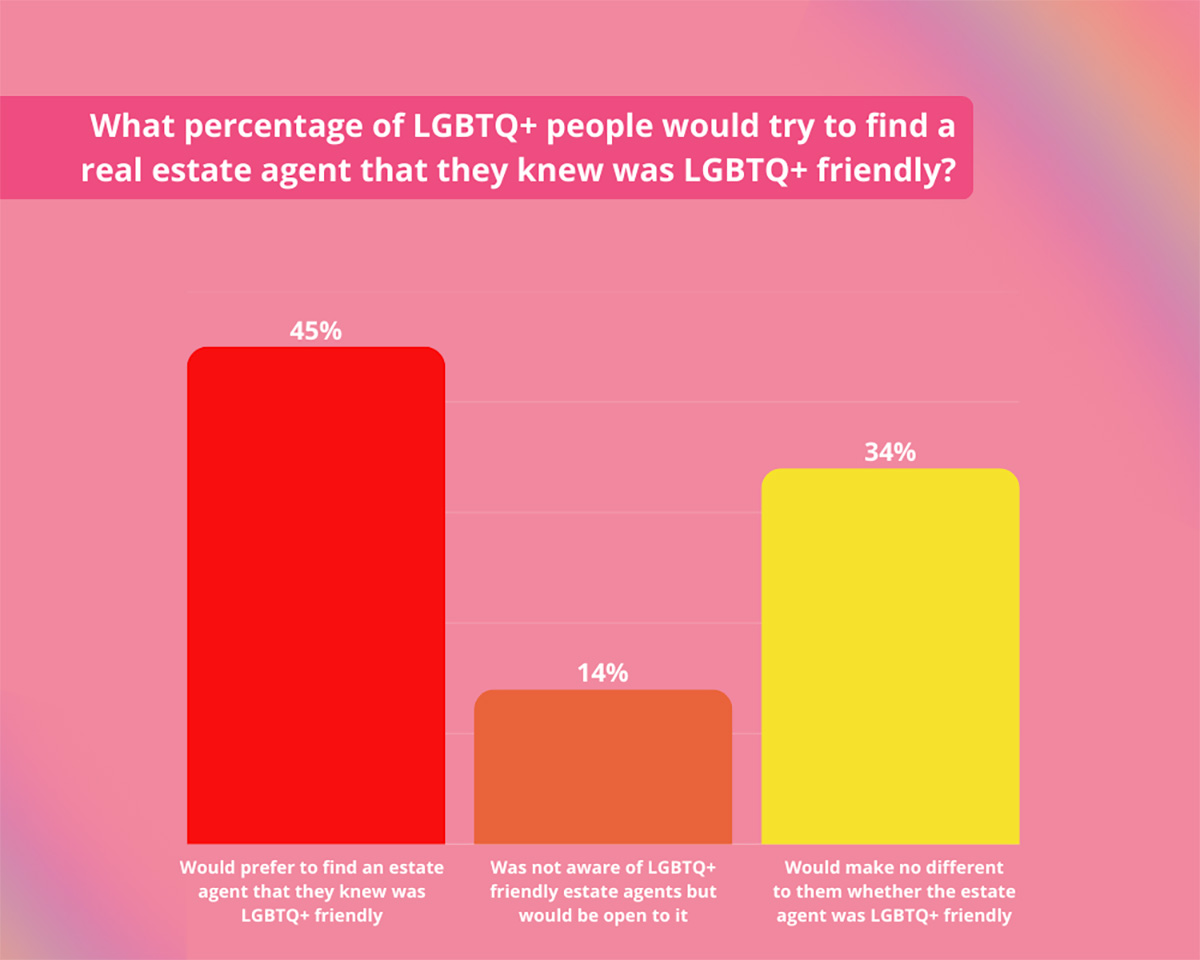
The Barriers to Ownership
The survey also reveals how multiple obstacles stack together, slowing or even stopping LGBTQ+ buyers from achieving homeownership. These barriers are not minor inconveniences but compounding pressures that reduce choice and delay progress. Key obstacles reported include:
- Concerns about harassment in certain areas.
- Struggling to find LGBTQ+-friendly areas within budget.
- Lack of local legal protections.
- The need to hide or downplay their identity to secure housing.
- Direct discrimination from sellers, agents, or landlords.
- The lack of inclusive schools and family resources.
- Access to healthcare.
- Facing negative housing experiences related to their LGBTQ+ identity.
In total, that’s 76% of the community that reports facing at least one barrier connected to their discrimination or identity.
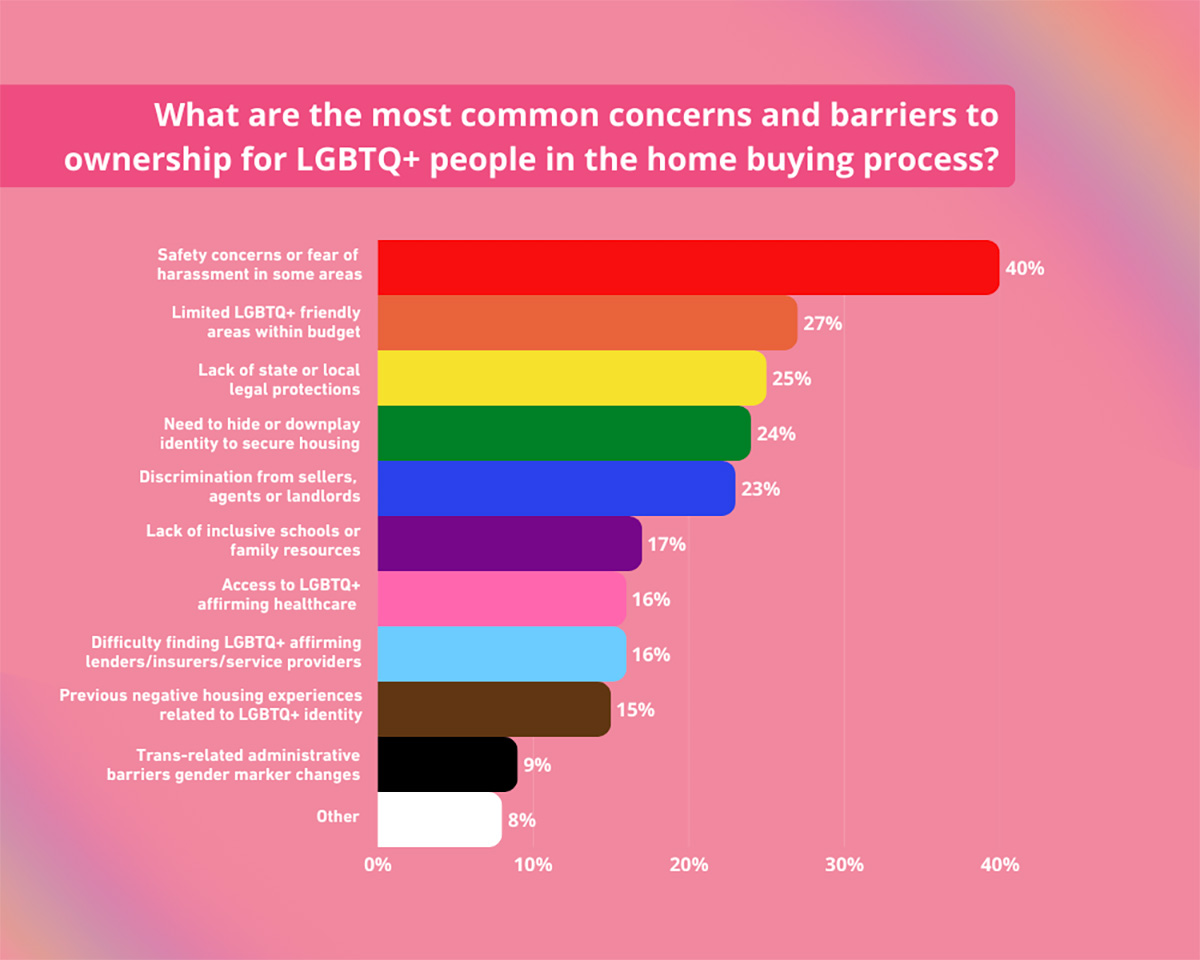
Patterns of Incidents
Discrimination is not always obvious, but it may leave a paper trail. Survey respondents reported harassment, exclusion, and unfavorable terms across many different stages of the buying process, including:
- Harassment, derogatory comments, or intimidation (9%).
- Being steered to or away from certain areas (7%).
- Discrimination by a landlord or property manager (5%).
- Discrimination by a seller or real estate agent (5%)
- Being refused a viewing or property (4%)
- Being offered worse terms, higher prices, or additional conditions (4%)
Recognizing these patterns is the first step, but buyers should also document these incidents, keep written records, and work with agents who can support them in escalating issues when necessary.
Moving forward with support
Buying a home is never just about property. It’s about belonging, stability, and being able to live authentically. The LGBTQ+ Home Ownership Index 2025 shows how discrimination, concealment, and external pressures continue to shape this journey, but it also highlights the resilience of those navigating it.
At Gay Real Estate, we believe no one should have to compromise their identity to find the right home. Our network of LGBTQ+-friendly agents is here to provide knowledgeable, affirming support from the first search to closing day.
If you’re ready to start your home search with an agent who understands your needs, connect with an LGBTQ+ friendly real estate agent today.
Methodology
A survey of 700 people from the USA was commissioned by Gay Real Estate. Respondents were all a part of the LGBTQ+ community to provide real-life experiences and accurate results.
For more information visit GayRealEstate.com.
-

 U.S. Supreme Court3 days ago
U.S. Supreme Court3 days agoSupreme Court rejects Kim Davis’s effort to overturn landmark marriage ruling
-

 District of Columbia3 days ago
District of Columbia3 days agoCapital Pride files anti-stalking complaint against local LGBTQ activist
-

 Politics12 hours ago
Politics12 hours agoPro-trans candidates triumph despite millions in transphobic ads
-

 Dining3 days ago
Dining3 days agoSpark Social House to start serving alcohol

